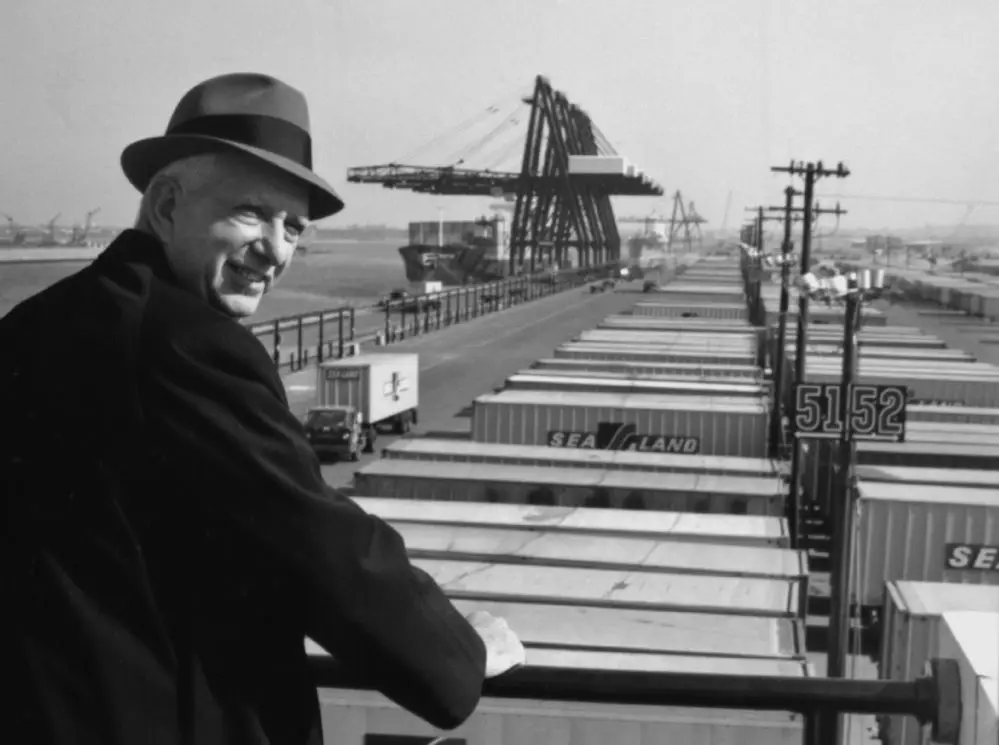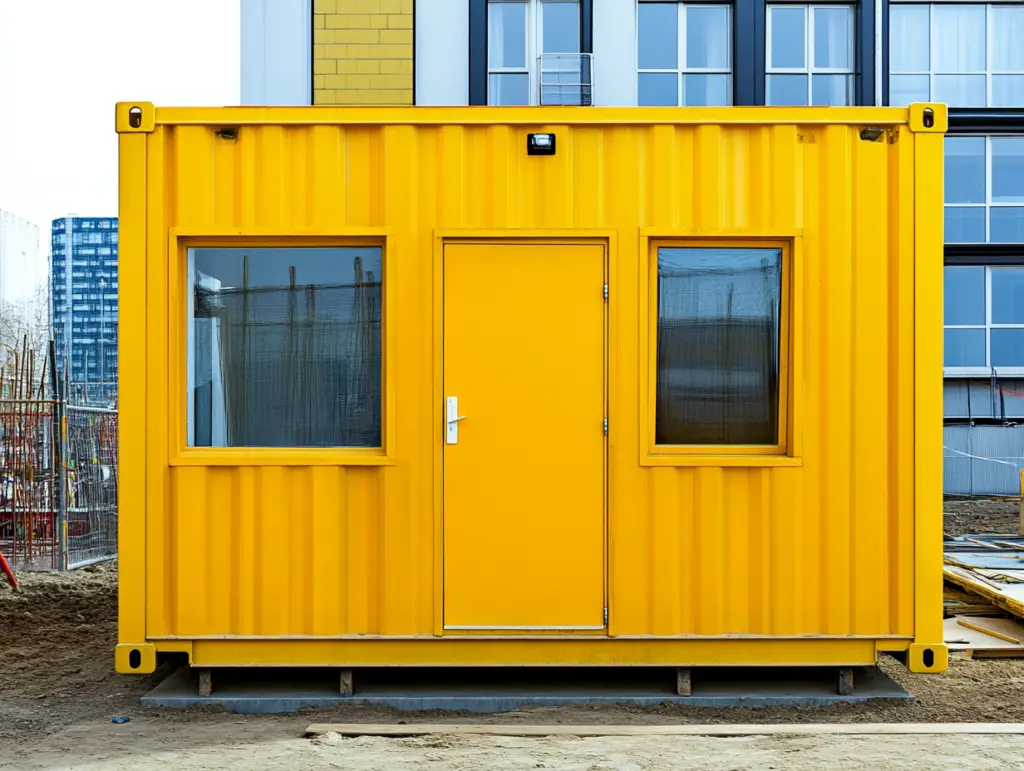The shipping container is one of the most revolutionary inventions of the 20th century—a straightforward steel box that transformed global trade, logistics, and economies across the world.
But who came up with this everyday object that now transports over 90% of the planet’s goods? The answer leads us to one man: Malcom McLean, an American trucking entrepreneur whose vision of “containerisation” reshaped how the world moves cargo. This article explores McLean’s story, the development of the shipping container, and its lasting influence on modern society.
The Man Behind the Idea: Malcom McLean
Malcom Purcell McLean, born in 1913 in Maxton, North Carolina, wasn’t an engineer or designer in the conventional sense. He was a self-made businessman with a sharp eye for efficiency. Starting out as a lorry driver in the 1930s, McLean eventually founded McLean Trucking Company, which became one of the largest haulage firms in the United States by the 1950s. His years in the transport industry gave him a front-row seat to the inefficiencies of cargo handling at the time.
Before the shipping container, goods were loaded and unloaded by hand in a process called “break-bulk” shipping. Workers would pack items into barrels, crates, or sacks, which were then hoisted onto ships, unpacked at the destination, and reloaded onto lorries or trains. This labour-intensive method was slow, expensive, and prone to damage or theft. McLean, irritated by watching hours of delays at ports as his lorries waited to unload, began to dream up a better system.
In 1956, McLean’s groundbreaking idea took shape: What if entire lorry trailers—or at least their cargo sections—could be loaded straight onto ships, removing the need to handle individual items? This concept, later refined into the standardised shipping container, didn’t come from a drawing board but from a practical, problem-solving mindset. Though McLean didn’t personally weld the first container or sketch its plans, he’s credited with designing the system of containerisation that became a global benchmark.

The Birth of the Shipping Container
McLean’s vision demanded more than just a bright idea—it required action. In 1955, he sold his trucking company for £4.8 million (adjusted for today’s value) and used the funds to buy Pan-Atlantic Steamship Corporation, a small shipping firm. He renamed it SeaLand and got to work turning his concept into reality. Collaborating with engineer Keith Tantlinger, whom McLean brought on to fine-tune the technical details, the first modern shipping containers were born.
Tantlinger was key in designing the container’s physical features. He crafted a steel box measuring 35 feet long, 8 feet wide, and 8 feet high, with reinforced corners and a twist-lock mechanism that allowed containers to be stacked securely and moved effortlessly between ships, lorries, and trains. While Tantlinger’s engineering skills brought precision to the project, it was McLean’s overarching vision that sparked the innovation. The first successful container shipment happened on 26 April 1956, when the SS Ideal-X, a converted World War II tanker, carried 58 containers from Newark, New Jersey, to Houston, Texas.
This maiden voyage showcased the idea’s potential. Loading costs fell from £4.66 per tonne with break-bulk methods to just £0.13 per tonne with containers. Transit times shortened, and theft—a constant headache at ports—dropped sharply since goods were sealed inside locked boxes. McLean’s design wasn’t merely a physical object; it was a system that linked transport modes into a smooth, efficient network.
Refining the Design: Standardisation and Growth
The early containers had their flaws. Their 35-foot length, rooted in McLean’s trucking background, didn’t match international norms. Over the next decade, McLean and Tantlinger collaborated with bodies like the International Organisation for Standardisation (ISO) to set uniform dimensions—most notably the 20-foot and 40-foot containers that dominate shipping today. These standardised sizes, locked in during the 1960s, ensured containers could be used interchangeably across ships, ports, and countries, securing containerisation’s worldwide uptake.
McLean’s role went beyond the initial design. He tirelessly championed containerisation, growing SeaLand’s operations and proving its worth. By the late 1960s, container shipping had reached Europe and Asia, boosted partly by the Vietnam War, where the U.S. military used containers to streamline supply chains. McLean’s determination turned a small-scale trial into an industry cornerstone.
The Impact of the Shipping Container
The shipping container’s influence is staggering. Before containerisation, shipping could account for up to 25% of a product’s cost; now, it’s often less than 1%. Ports that once relied on thousands of dockers now manage vastly more cargo with cranes and a smaller workforce. Cities like Shanghai, Singapore, and Rotterdam became global trade hubs thanks to container ports. Entire sectors—manufacturing, retail, agriculture—reorganised around the ability to shift goods cheaply and reliably across oceans.
Economists reckon containerisation doubled world trade between 1960 and 2000, lifting millions out of poverty by linking producers to far-off markets. The container also reshaped geopolitics, paving the way for export-led economies like China. In a sense, McLean’s design didn’t just move cargo—it ushered the world into globalisation.
Debates Over Credit
While McLean is widely hailed as the “father of containerisation,” some suggest the shipping container’s origins are trickier to pin down. Containers of sorts existed before McLean—railways used wooden boxes in the 19th century, and the U.S. military trialled metal “Conex” boxes during World War II. Yet these earlier attempts lacked the standardisation and systemic integration McLean pioneered. Keith Tantlinger also deserves hefty praise for the container’s practical design, but McLean’s name endures because he saw its potential and brought it to life.
McLean’s Legacy
Malcom McLean passed away in 2001 at age 87, but his legacy lives on in every port and warehouse worldwide. He wasn’t a traditional inventor poring over blueprints; he was a disruptor who spotted a problem, pictured a fix, and marshalled the resources to build it. His shipping container isn’t just a physical item—it’s a symbol of human ingenuity’s power to reshape the world.
Today, over 20 million shipping containers traverse the globe, each a tribute to McLean’s vision. From the clothes we wear to the gadgets we use, nearly everything we touch has likely spent time in one of these steel boxes. Next time you spot a container stacked on a ship or trundling past on a lorry, think of the man who designed not just the box, but the system that keeps our modern world ticking.
Conclusion
So, who designed the shipping container? Malcom McLean, with a vital assist from Keith Tantlinger, takes the crown. McLean’s brilliance lay in looking past the inefficiencies of his era and crafting a solution that was simple yet transformative. The shipping container may not have the allure of a rocket or the intricacy of a computer, but its impact rivals any invention of the modern age. Ultimately, McLean didn’t just design a box—he built the backbone of global trade.
Check out our latest blog posts

Small Shipping Containers: The Mighty Minis Revolutionising Storage and Beyond









